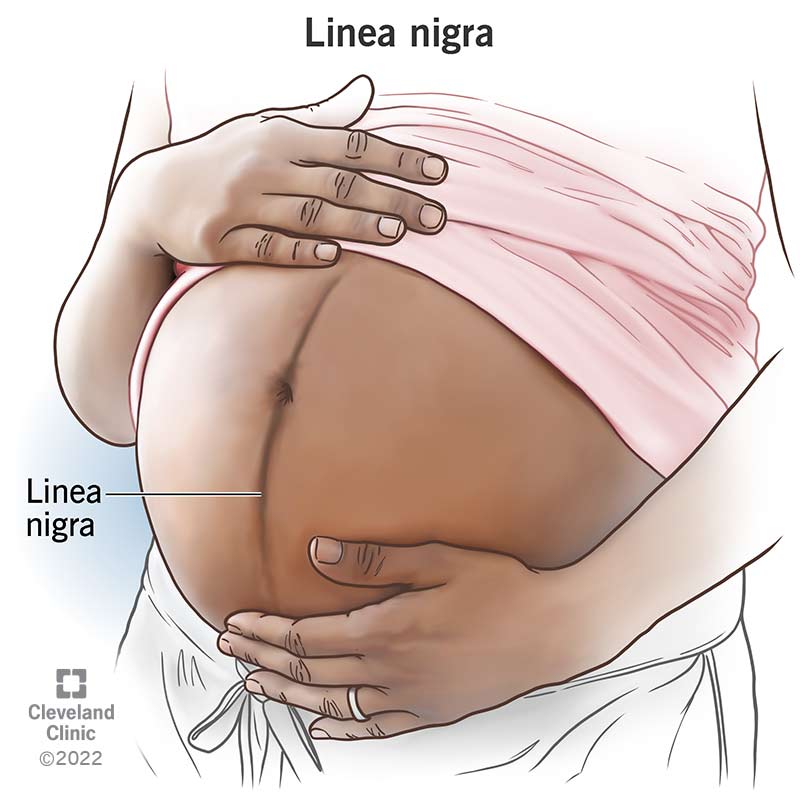Linea nigra is a dark line that develops on your stomach during pregnancy. It usually extends from your bellybutton to your pubic area. The linea nigra is caused by an increase in hormones and fades once your baby is born.
Advertisement
Cleveland Clinic is a non-profit academic medical center. Advertising on our site helps support our mission. We do not endorse non-Cleveland Clinic products or services. Policy

The linea nigra is a dark vertical line that appears on the skin of your stomach during pregnancy. It's also called the pregnancy line. It runs from your belly button to your public area but can extend towards your abdomen. The linea nigra may appear darker as your pregnancy develops and is more visible in people with darker complexions. Linea nigra is Latin for "black line."
Advertisement
Cleveland Clinic is a non-profit academic medical center. Advertising on our site helps support our mission. We do not endorse non-Cleveland Clinic products or services. Policy
You always have a linea nigra, but it's nearly invisible until your hormones rise during pregnancy. In most people, the linea nigra darkens enough to be visible in the second trimester (around 20 weeks). Before you're pregnant, the line is called linea alba or "white line." When you are pregnant and the line gets dark and visible, it's called linea nigra.
The linea nigra will fade after pregnancy when your hormone levels return to regular levels. The fading is gradual over several weeks or months. In some cases, it doesn't entirely disappear or takes a lot longer to go away.
Up to about 80% of pregnant women will have a linea nigra, but it may be more or less noticeable depending on your skin color. Those with darker complexions tend to have a more pronounced linea nigra compared to those with fair complexions. This is because people with darker skin have more pigmentation than those with light skin.
No one is sure what the linea nigra is for. Some have speculated that the darker color helps a newborn baby find its way up to the breasts to nurse (breastfeed). There are other old wives' tales that you may hear about the linea nigra, but none have been proven.
The linea nigra appears naturally during pregnancy because of the higher levels of hormones in your body. The exact cause isn't known, but most healthcare providers believe that the melanocyte-stimulating hormone created by the placenta causes melanin to rise during pregnancy. Melanin is responsible for giving your skin its color. This increase in melanin causes your skin to darken during pregnancy. This same hormone is responsible for causing melasma and darker areolas. No one is sure why certain areas of the body are affected and others are not.
Advertisement
The linea nigra is about 1/4 to 1/2 inches wide and stretches from your pubic bone to your belly button. In some cases, it extends past the belly button towards your breasts. It's darker than your skin color and can appear brown or light black. Your linea nigra stays a consistent width from the top to the bottom. It's not a cause for worry and doesn't indicate there are issues with your pregnancy or your skin.
No, you can't prevent getting the linea nigra. It's connected to hormone changes in your body. It will lessen and fade away after your baby is born.
No, the linea nigra is not associated with any medical conditions during pregnancy. It's a completely normal part of being pregnant.
No, you can't make it go away. Healthcare providers don't recommend applying medications, topical ointments or other bleaching agents to your skin while you are pregnant. Wearing sunscreen can be beneficial as ultraviolet rays from the sun can intensify the color of your linea nigra. Folic acid may help reduce the intensity of the linea nigra. Folic acid is found in foods such as leafy green vegetables, beans and whole wheat bread.
Using a bleaching cream may be an option after your baby is born, but only if you are not breastfeeding.
Applying makeup to cover your linea nigra is an option if the dark line is bothering you or if it doesn't fade away fast enough. Talk to your healthcare provider if you are concerned about the appearance of your linea nigra.
Yes, more than likely it will appear each pregnancy. It may look different each time (darker or lighter than before) or appear earlier (or later) than before. Some people feel like it takes longer to go away with each pregnancy, but that hasn't been proven.
Linea nigra can appear in children and people who are not pregnant. The linea nigra doesn't always fade completely, leaving some people with a permanent, faint linea nigra after they deliver their baby.
Healthcare providers aren't entirely sure why the linea nigra gets darker in people who aren't pregnant, but it seems to be connected to hormones. Certain medications or underlying health conditions could contribute to making your linea alba appear darker. Talk to your healthcare provider if you are not pregnant but have a visible linea nigra.
Linea nigra occurs in pregnancy because your hormones cause your skin to change color. Talk to your healthcare provider if the color of your linea nigra is bothering you to see if they can help. The good news is that your linea nigra should fade after you give birth and your hormones return to regular levels.
Advertisement
Trying to choose where to give birth? Learn why Cleveland Clinic is the best choice to help you through each step of the labor and delivery process.

Last reviewed on 07/18/2022.
Learn more about the Health Library and our editorial process.